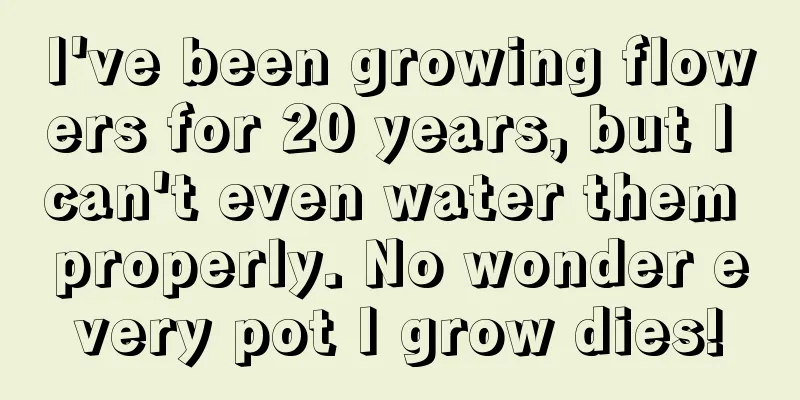I've been growing flowers for 20 years, but I can't even water them properly. No wonder every pot I grow dies!

Water when the soil is drySome flower lovers are more careful. When they see the flowers at home, they always want to water them, thinking that they will grow a lot immediately after watering. In fact, they are not as short of water as we imagined. Once watered, the flowers and plants cannot drink all the water, and the flowerpots immediately become "ponds". In fact, to judge whether the flowers and plants are thirsty, just look at the soil. It is often said that flowers should be watered when the soil is dry. How do you judge whether the soil is dry? 1. Check whether the soil in the pot is white Just look at whether the soil in the pot is white. As shown in the picture above, the soil on the left is light in color and needs to be watered; the flowerpot on the right has just been watered. 2. Rub your fingers together Rub the soil with your fingers to see if it is dry. If the soil is easily broken or becomes powdery, you should water it immediately. 3. Insert a toothpick as a signal You can insert the toothpick into the soil, but be careful to insert it along the edge of the flowerpot so that it is not easy to pierce the roots of the flowers. A long bamboo stick will do, just insert it 3-5 cm into the soil Pull out the skewer. If you see moisture only 2 cm below the soil layer (the green distance in the picture above), it means the soil has started to dry out. If it exceeds 2 cm, it is very dry, so water it quickly. When to waterDo you water the plants only when you remember to do so, and just not water them if you don’t remember to do so? Sometimes we forget to water flowers. You know, watering them at random regardless of the time will really kill them. It is better not to water them! 1. Watering in the morning (6:00-9:00) The temperature is low at night, and after a night, the temperature of the flower pot is also low. Watering early in the morning will not affect their metabolism or hurt the roots. After watering the flowers early in the morning, the water is so refreshing. 2. Is it okay to water at noon? The temperature is highest at noon, and the internal activities of flowers and plants are faster. When watering at this time, the soil in the pot will suddenly cool down, which will hurt them. The sun is strong at noon, and the flowers may wilt a little. Don't be impatient, wait and water them again~ However, noon in winter is a good time to water, because the temperature at noon is the highest in the day, and the circulation in the bodies of flowers and plants begins to return to normal, making this a suitable time for watering. It is not suitable for watering if it is too cold in the morning and evening. 3. Watering is possible in the evening (18:00-20:00) After the temperature drops in the evening, feel the temperature of the flower pot. As long as it is normal, you can water it. At this time, it is not suitable to water it thoroughly, just slightly wet the surface of the pot. What kind of water is good?1. Tap water I believe everyone just waters the plants with tap water. There’s no need to worry about taking care of the flowers and plants! However, tap water contains elements such as chlorine, and water from different places has acid and alkaline properties, some of which are not conducive to plant growth. We can put the tap water on the balcony to dry for a few days before watering. This will be much better. 2. Pond and lake water Relatively clear pond and lake water can be used as watering water. It contains some microbial nutrients and is very suitable for watering orchids, roses, camellias and some large flowers and plants. If you find something clean, you can put it back and put it aside for a day or two to let the impurities settle before using it again. 3. Rainwater Rainwater can also be used to water flowers, but not all flowers. For example, in places with serious air pollution, the rainwater is very dirty. If the environment at home is good, you can collect rainwater to water the flowers~ Please note that you still need to let it sit for 1-2 days to let the impurities settle before use. That’s all about watering flowers What else do you guys think? Let's share it together |
Recommend
How to grow rainbow jade to make it red and beautiful
Curing temperature When growing rainbow jade, if ...
Common methods of seed germination (five methods of seed germination and the whole process)
Now is the sowing season, and people who like to ...
What trees are suitable for planting in the shady yard? Four trees suitable for planting in the shady side of the courtyard
The shady yard does not have enough sunlight, so ...
The efficacy and function of peony flowers, and drinking taboos
1. The efficacy and function of peony flowers 1. ...
How to treat rust spots on the leaves of Ficus microcarpa? Can they be restored?
1. Causes of rust spots The rust spots on the lea...
When is the best time to harvest Chinese cabbage?
Chinese cabbage harvest time The best time to har...
How to grow Mimosa pudica
Water frequently Mimosa is a moisture-loving flow...
Can hibiscus trees be potted?
Can hibiscus trees be potted? Hibiscus trees can ...
Can plum trees be propagated by cuttings? Time and method of propagation by cuttings
Can plum trees be propagated by cuttings? Plum tr...
Hydroponic method of jade tree
Remove from the basin It is best to do cuttings b...
Transplantation method of lucky bamboo buds
1. How to promote the growth of side shoots Remov...
The advantages and disadvantages of talking about roses
The Shuochou rose is a rose with rose-red and whi...
How to grow mung beans in small pots using hydroponics
1. Soak mung beans Choose the right mung beans, w...
How to grow golden leaf sedum
1. Soil It has strong adaptability and can grow w...
Plantago cultivation methods and precautions
1. Maintenance methods 1. Soil: Plantain likes to...









